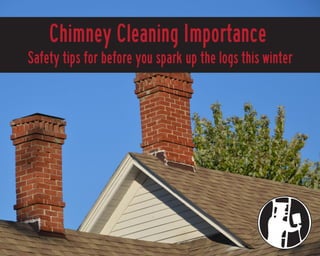Chimney Cleaning Importance Safety tips for before you spark up the logs this winter
•
0 likes•997 views
Cleaning and maintaining chimneys is important for safety. Hiring a professional chimney sweep once a year before winter can prevent fires. The sweep should inspect for damage to the chimney structure, flue liner, and cap. When lighting fires, use dry hardwoods and don't overfill the fireplace. Always use a spark guard and build the fire safely against the back wall.
Report
Share
Report
Share
Download to read offline

More Related Content
What's hot (14)
Improving Energy Efficiency on Traditional Buildings

Improving Energy Efficiency on Traditional Buildings
Similar to Chimney Cleaning Importance Safety tips for before you spark up the logs this winter
Similar to Chimney Cleaning Importance Safety tips for before you spark up the logs this winter (20)
A Comprehensive Chimney Care Guide for Chimney Owners.pptx

A Comprehensive Chimney Care Guide for Chimney Owners.pptx
'Protecting Your Home from Wildfire' - Fireman's Fund Insurance Company

'Protecting Your Home from Wildfire' - Fireman's Fund Insurance Company
Candles - Handle with Care - Potential Health & Safety Implications 

Candles - Handle with Care - Potential Health & Safety Implications
Recently uploaded
Recently uploaded (20)
Housing Price Regulation Thesis Defense by Slidesgo.pptx

Housing Price Regulation Thesis Defense by Slidesgo.pptx
Kohinoor Teiko Hinjewadi Phase 2 Pune E-Brochure.pdf

Kohinoor Teiko Hinjewadi Phase 2 Pune E-Brochure.pdf
Retail Space for Lease - 1221 W. Main St., Sun Prairie, WI

Retail Space for Lease - 1221 W. Main St., Sun Prairie, WI
Call girls in Shakti Nagar Delhi~8447779280°/=@/ Short 1500 Night 6000}ESCORT...

Call girls in Shakti Nagar Delhi~8447779280°/=@/ Short 1500 Night 6000}ESCORT...
MEQ Mainstreet Equity Corp Q2 2024 Investor Presentation

MEQ Mainstreet Equity Corp Q2 2024 Investor Presentation
Call Girls in Maurice Nagar (Delhi) ꧁8447779280꧂ Female Escorts Service in De...

Call Girls in Maurice Nagar (Delhi) ꧁8447779280꧂ Female Escorts Service in De...
Low Density Living New Project in BPTP THE AMAARIO Sector 37D Gurgaon Haryana...

Low Density Living New Project in BPTP THE AMAARIO Sector 37D Gurgaon Haryana...
Low Rate ✨➥9711108085▻✨Call Girls In East Of Kailash (E.K) (Delhi)

Low Rate ✨➥9711108085▻✨Call Girls In East Of Kailash (E.K) (Delhi)
Low rate ↬Call girls in Sabzi Mandi Delhi | 8447779280}Escort Service In All ...

Low rate ↬Call girls in Sabzi Mandi Delhi | 8447779280}Escort Service In All ...
Cheap Rate ✨➥9582086666▻✨Call Girls In Gurgaon Sector 1 (Gurgaon)

Cheap Rate ✨➥9582086666▻✨Call Girls In Gurgaon Sector 1 (Gurgaon)
BPTP THE AMAARIO For The Royals Of Tomorrow in Sector 37D Gurgaon Dwarka Expr...

BPTP THE AMAARIO For The Royals Of Tomorrow in Sector 37D Gurgaon Dwarka Expr...
Kohinoor Courtyard One Wakad Pune | Elegant Living Spaces

Kohinoor Courtyard One Wakad Pune | Elegant Living Spaces
Chimney Cleaning Importance Safety tips for before you spark up the logs this winter
- 1. Chimney Cleaning Importance Safety tips for before you spark up the logs this winter
- 2. With natural gas and propane costs rising, you'll likely be looking to the old chimney this winter to help cut your home-warming bills. In any case, before you start up the logs, note that chimneys and chimneys are associated with 42 percent of all home fires. So first ensure yours is up to snuff by following the security tips underneath.
- 3. Contract a chimney sweep. The National Fire Protection Association suggests that chimneys be cleared at least once per year toward the start of the winter to evacuate residue and garbage.
- 4. Check for damage. After cleaning, a professional ought to review the chimney structure for splits, loose blocks, or missing mortar. Fireplace liners ought to likewise be checked for breaking or weakening.
- 5. Cap the chimney. A cap fitted with wire-mesh sides covers the highest point of the chimney and keeps rain, winged animals, squirrels, and flotsam and jetsam from entering. Supplant or repair a cap that is absent or harmed.
- 6. Consume prepared hardwoods. Pick thick wood, for example, oak, that has been cut and put away in a dry place for no less than a half year. Green wood and resinous softwoods like pine deliver more creosote, a combustible side-effect of wood burning that can develop in the fireplace.
- 7. Try not to over-stack. Little flames produce less smoke, and thus have less creosote development. Likewise, a fire that is too substantial or excessively hot can break the chimney.
- 8. Build it right. Place logs at the back of the chimney on a metal mesh. Utilize kindling, instead of combustible fluids, to begin the fire.
- 9. Utilize a spark guard. Keep errant embers from shooting out of the firebox with a metal screen or glass chimney entryways. A guard in front of an open flame is especially important when the room is unoccupied.